International Business: A Case Study on Coca-Cola's Operations
VerifiedAdded on 2020/01/07
|10
|3139
|224
Case Study
AI Summary
This case study delves into Coca-Cola's international business operations, providing a comprehensive analysis of its strategies and challenges in the global market. The study begins with an introduction to international business and its significance, followed by a detailed PESTEL analysis, examining the political, economic, social, technological, legal, and environmental factors impacting Coca-Cola. It then applies Porter's Five Forces model to assess the competitive landscape, including the threat of new entrants, bargaining power of buyers and suppliers, threat of substitutes, and rivalry among existing firms. The Hofstede cultural model is used to analyze cultural dimensions and their impact on Coca-Cola's operations. The case study concludes by evaluating Coca-Cola's adaptation to local cultures and diversity, emphasizing the importance of balancing efficiency, cost-effectiveness, and customer significance. The study uses several academic resources to support its findings.
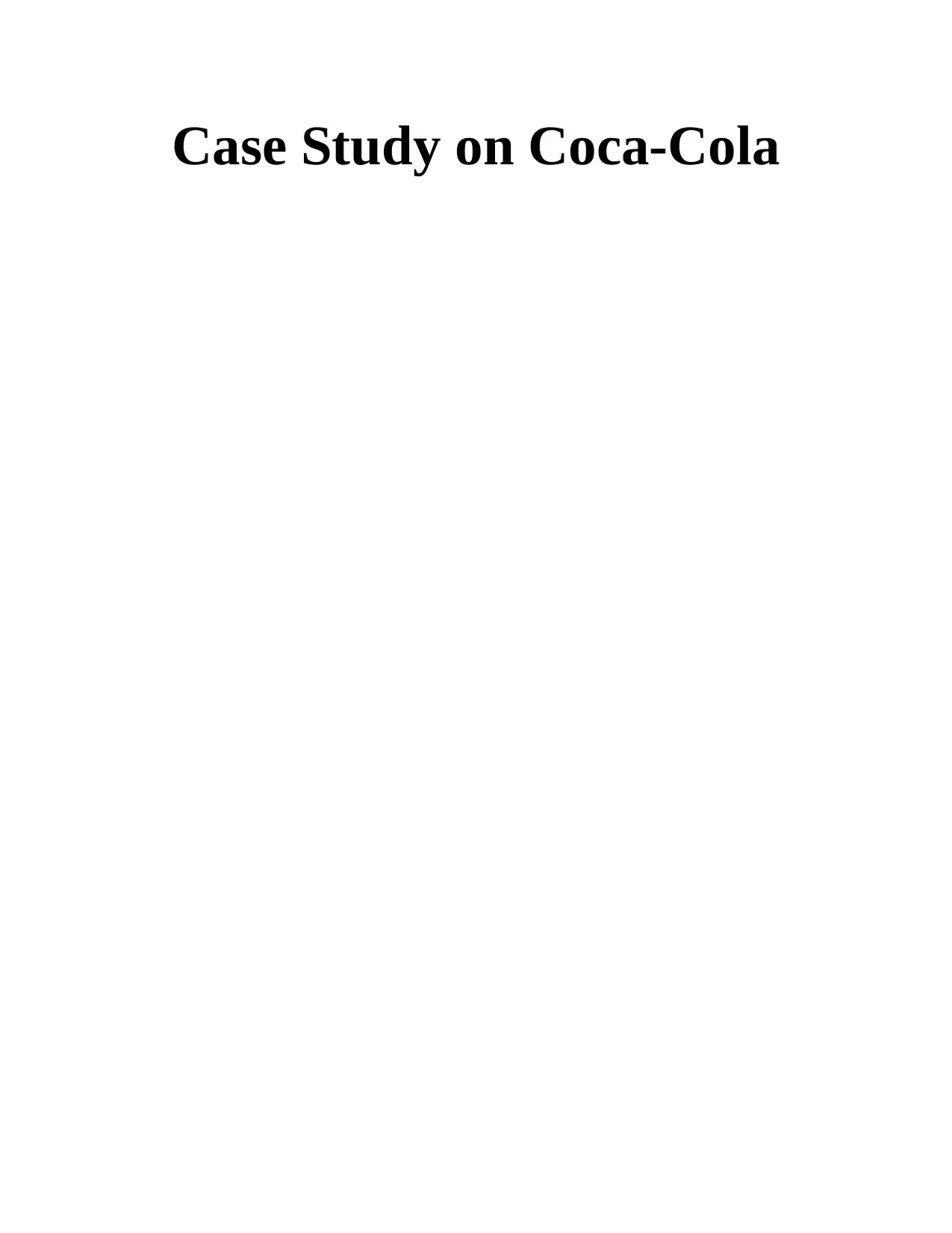
Case Study on Coca-Cola
Paraphrase This Document
Need a fresh take? Get an instant paraphrase of this document with our AI Paraphraser
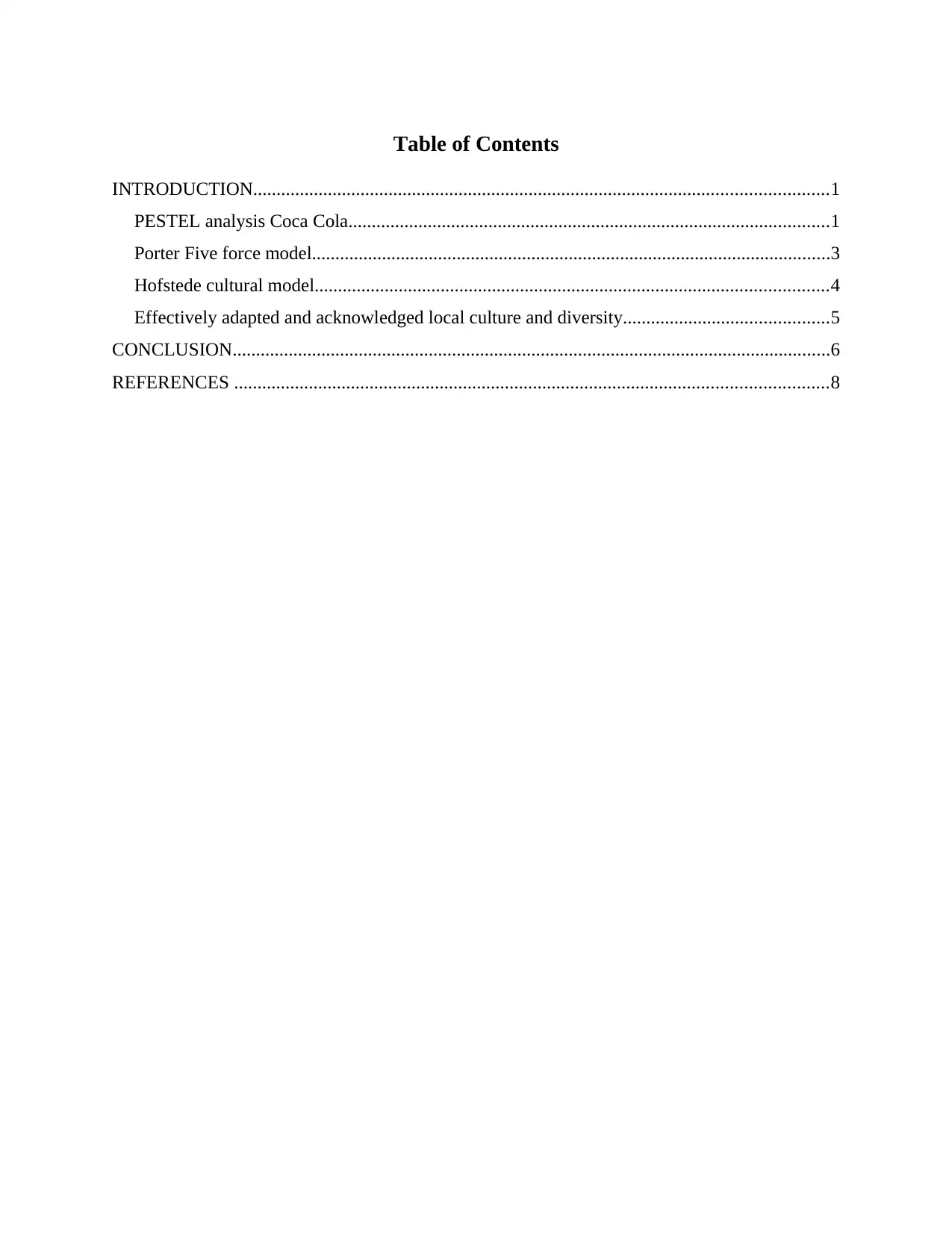
Table of Contents
INTRODUCTION...........................................................................................................................1
PESTEL analysis Coca Cola.......................................................................................................1
Porter Five force model...............................................................................................................3
Hofstede cultural model..............................................................................................................4
Effectively adapted and acknowledged local culture and diversity............................................5
CONCLUSION................................................................................................................................6
REFERENCES ...............................................................................................................................8
INTRODUCTION...........................................................................................................................1
PESTEL analysis Coca Cola.......................................................................................................1
Porter Five force model...............................................................................................................3
Hofstede cultural model..............................................................................................................4
Effectively adapted and acknowledged local culture and diversity............................................5
CONCLUSION................................................................................................................................6
REFERENCES ...............................................................................................................................8

INTRODUCTION
International business consists of different commercial transactions within private, public
and governmental to carry out business operations within two or more regions but does not affect
the political boundaries. Thus, it is essential for firm to
identify the opportunities and threats related to firm and try to minimize to overcome the issue
identified within business (Alon, Jaffe and Vianelli, 2012). In the present study, Coca Cola has
been undertaken assessing nature and business impacts upon the external global environment has
had on markets in which the business carries out its functions. Further, it has been examined how
effectively business has adapted and acknowledged local culture and diversity and maintained
balance between the need for efficiency, cost effectiveness and customer significance.
PESTEL analysis Coca Cola
Coca Cola is one of the soft drink organizations and thus serves customers worldwide.
However, to supply appropriate soft drink to customers, business aims to carry out strict
regulations and also comply to consumer demands as well as use the latest technology so that
best results can be attained (Ashworth, 2012). Following is the PESTEL analysis for Coca Cola
such as-
Political factors- Operations of Coca Cola has been impacted by particular set of
political factors across worldwide market. Thus, political stability impacts upon the
international pressure group and thus it is essential for business to identify the
government attitude towards the industry as well as firm. There were several movements
that were carried out against Coca Cola around the world that affects the operations of
firm in market. Also, it involves different changes which were established in order to
protect Coca Cola from different laws and attain desired results (Amatulli and Guido,
2012).
Economic factors- Further, sales of Coca Cola have been impacted by a set of particular
economic factors which were beyond firm's control. Thus, such factors involve the level
of economic growth in the country and industry, tax ates, currency exchange rates,
interest rates etc. However, the financial crisis impacts the firms operations as compared
to other businesses (Barbosa and et. al., 2015). Because at the time of crisis in the
country, consumers does not have high purchasing power and thus they do not spend
1
International business consists of different commercial transactions within private, public
and governmental to carry out business operations within two or more regions but does not affect
the political boundaries. Thus, it is essential for firm to
identify the opportunities and threats related to firm and try to minimize to overcome the issue
identified within business (Alon, Jaffe and Vianelli, 2012). In the present study, Coca Cola has
been undertaken assessing nature and business impacts upon the external global environment has
had on markets in which the business carries out its functions. Further, it has been examined how
effectively business has adapted and acknowledged local culture and diversity and maintained
balance between the need for efficiency, cost effectiveness and customer significance.
PESTEL analysis Coca Cola
Coca Cola is one of the soft drink organizations and thus serves customers worldwide.
However, to supply appropriate soft drink to customers, business aims to carry out strict
regulations and also comply to consumer demands as well as use the latest technology so that
best results can be attained (Ashworth, 2012). Following is the PESTEL analysis for Coca Cola
such as-
Political factors- Operations of Coca Cola has been impacted by particular set of
political factors across worldwide market. Thus, political stability impacts upon the
international pressure group and thus it is essential for business to identify the
government attitude towards the industry as well as firm. There were several movements
that were carried out against Coca Cola around the world that affects the operations of
firm in market. Also, it involves different changes which were established in order to
protect Coca Cola from different laws and attain desired results (Amatulli and Guido,
2012).
Economic factors- Further, sales of Coca Cola have been impacted by a set of particular
economic factors which were beyond firm's control. Thus, such factors involve the level
of economic growth in the country and industry, tax ates, currency exchange rates,
interest rates etc. However, the financial crisis impacts the firms operations as compared
to other businesses (Barbosa and et. al., 2015). Because at the time of crisis in the
country, consumers does not have high purchasing power and thus they do not spend
1
⊘ This is a preview!⊘
Do you want full access?
Subscribe today to unlock all pages.

Trusted by 1+ million students worldwide
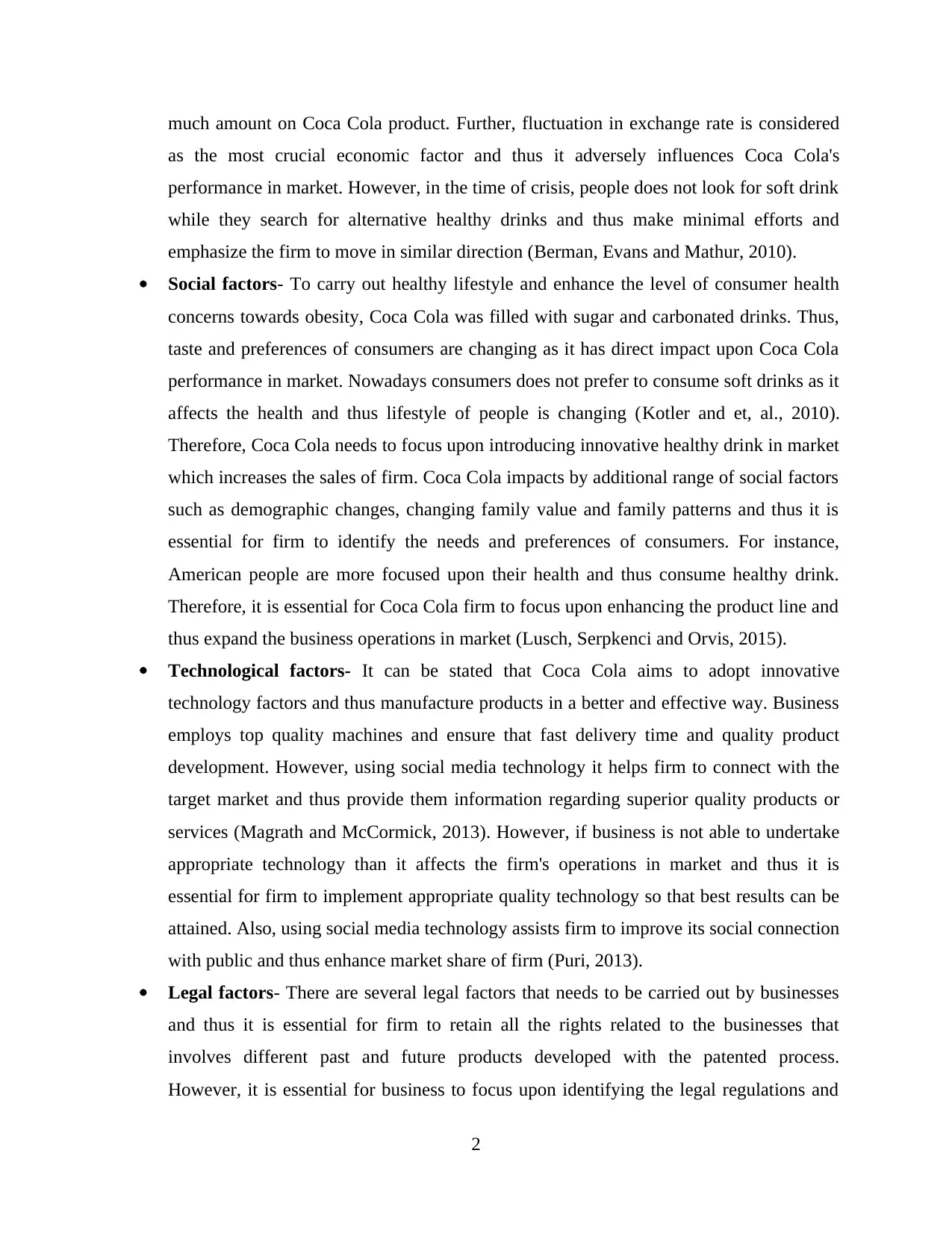
much amount on Coca Cola product. Further, fluctuation in exchange rate is considered
as the most crucial economic factor and thus it adversely influences Coca Cola's
performance in market. However, in the time of crisis, people does not look for soft drink
while they search for alternative healthy drinks and thus make minimal efforts and
emphasize the firm to move in similar direction (Berman, Evans and Mathur, 2010).
Social factors- To carry out healthy lifestyle and enhance the level of consumer health
concerns towards obesity, Coca Cola was filled with sugar and carbonated drinks. Thus,
taste and preferences of consumers are changing as it has direct impact upon Coca Cola
performance in market. Nowadays consumers does not prefer to consume soft drinks as it
affects the health and thus lifestyle of people is changing (Kotler and et, al., 2010).
Therefore, Coca Cola needs to focus upon introducing innovative healthy drink in market
which increases the sales of firm. Coca Cola impacts by additional range of social factors
such as demographic changes, changing family value and family patterns and thus it is
essential for firm to identify the needs and preferences of consumers. For instance,
American people are more focused upon their health and thus consume healthy drink.
Therefore, it is essential for Coca Cola firm to focus upon enhancing the product line and
thus expand the business operations in market (Lusch, Serpkenci and Orvis, 2015).
Technological factors- It can be stated that Coca Cola aims to adopt innovative
technology factors and thus manufacture products in a better and effective way. Business
employs top quality machines and ensure that fast delivery time and quality product
development. However, using social media technology it helps firm to connect with the
target market and thus provide them information regarding superior quality products or
services (Magrath and McCormick, 2013). However, if business is not able to undertake
appropriate technology than it affects the firm's operations in market and thus it is
essential for firm to implement appropriate quality technology so that best results can be
attained. Also, using social media technology assists firm to improve its social connection
with public and thus enhance market share of firm (Puri, 2013).
Legal factors- There are several legal factors that needs to be carried out by businesses
and thus it is essential for firm to retain all the rights related to the businesses that
involves different past and future products developed with the patented process.
However, it is essential for business to focus upon identifying the legal regulations and
2
as the most crucial economic factor and thus it adversely influences Coca Cola's
performance in market. However, in the time of crisis, people does not look for soft drink
while they search for alternative healthy drinks and thus make minimal efforts and
emphasize the firm to move in similar direction (Berman, Evans and Mathur, 2010).
Social factors- To carry out healthy lifestyle and enhance the level of consumer health
concerns towards obesity, Coca Cola was filled with sugar and carbonated drinks. Thus,
taste and preferences of consumers are changing as it has direct impact upon Coca Cola
performance in market. Nowadays consumers does not prefer to consume soft drinks as it
affects the health and thus lifestyle of people is changing (Kotler and et, al., 2010).
Therefore, Coca Cola needs to focus upon introducing innovative healthy drink in market
which increases the sales of firm. Coca Cola impacts by additional range of social factors
such as demographic changes, changing family value and family patterns and thus it is
essential for firm to identify the needs and preferences of consumers. For instance,
American people are more focused upon their health and thus consume healthy drink.
Therefore, it is essential for Coca Cola firm to focus upon enhancing the product line and
thus expand the business operations in market (Lusch, Serpkenci and Orvis, 2015).
Technological factors- It can be stated that Coca Cola aims to adopt innovative
technology factors and thus manufacture products in a better and effective way. Business
employs top quality machines and ensure that fast delivery time and quality product
development. However, using social media technology it helps firm to connect with the
target market and thus provide them information regarding superior quality products or
services (Magrath and McCormick, 2013). However, if business is not able to undertake
appropriate technology than it affects the firm's operations in market and thus it is
essential for firm to implement appropriate quality technology so that best results can be
attained. Also, using social media technology assists firm to improve its social connection
with public and thus enhance market share of firm (Puri, 2013).
Legal factors- There are several legal factors that needs to be carried out by businesses
and thus it is essential for firm to retain all the rights related to the businesses that
involves different past and future products developed with the patented process.
However, it is essential for business to focus upon identifying the legal regulations and
2
Paraphrase This Document
Need a fresh take? Get an instant paraphrase of this document with our AI Paraphraser
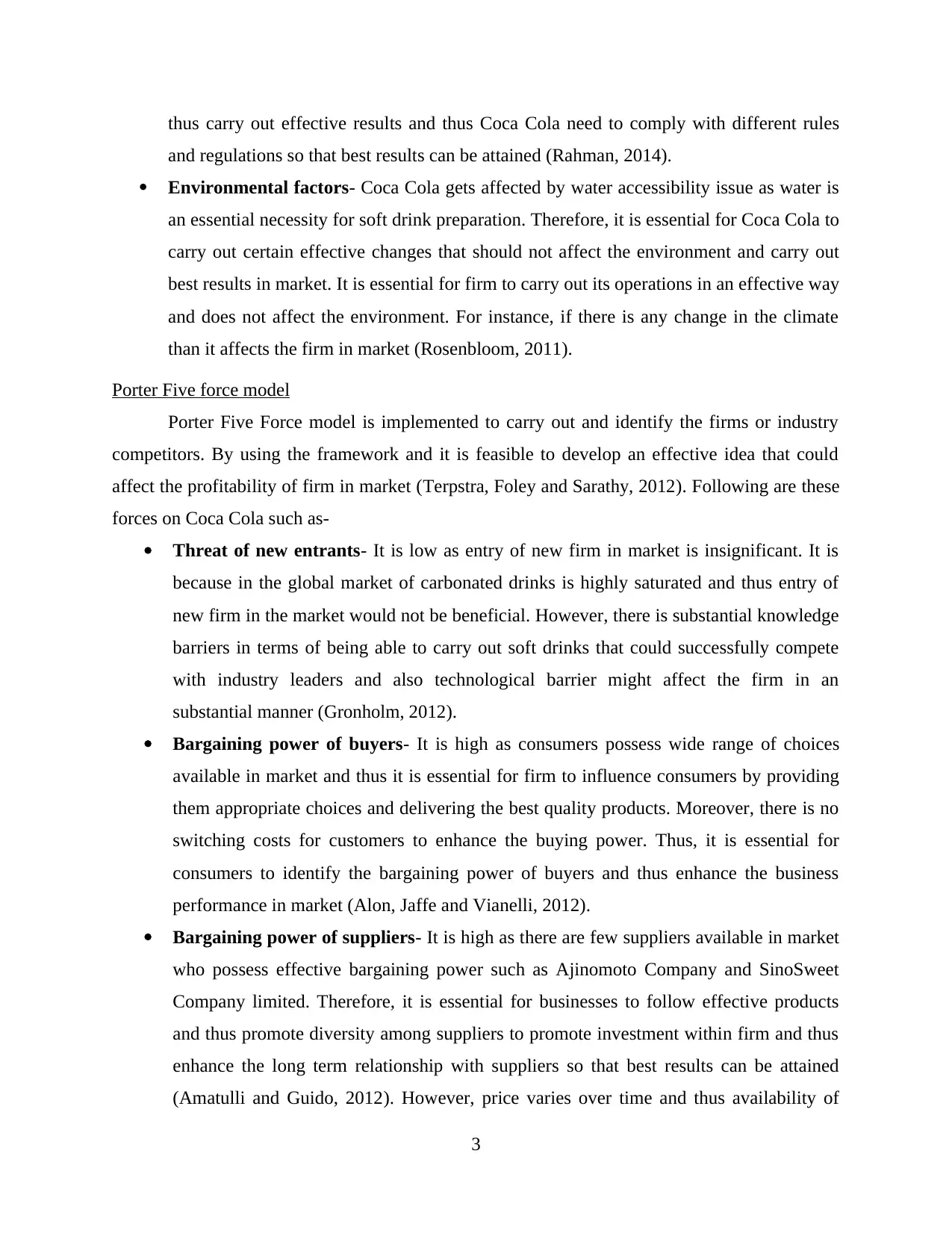
thus carry out effective results and thus Coca Cola need to comply with different rules
and regulations so that best results can be attained (Rahman, 2014).
Environmental factors- Coca Cola gets affected by water accessibility issue as water is
an essential necessity for soft drink preparation. Therefore, it is essential for Coca Cola to
carry out certain effective changes that should not affect the environment and carry out
best results in market. It is essential for firm to carry out its operations in an effective way
and does not affect the environment. For instance, if there is any change in the climate
than it affects the firm in market (Rosenbloom, 2011).
Porter Five force model
Porter Five Force model is implemented to carry out and identify the firms or industry
competitors. By using the framework and it is feasible to develop an effective idea that could
affect the profitability of firm in market ( Terpstra, Foley and Sarathy, 2012). Following are these
forces on Coca Cola such as-
Threat of new entrants- It is low as entry of new firm in market is insignificant. It is
because in the global market of carbonated drinks is highly saturated and thus entry of
new firm in the market would not be beneficial. However, there is substantial knowledge
barriers in terms of being able to carry out soft drinks that could successfully compete
with industry leaders and also technological barrier might affect the firm in an
substantial manner ( Gronholm, 2012).
Bargaining power of buyers- It is high as consumers possess wide range of choices
available in market and thus it is essential for firm to influence consumers by providing
them appropriate choices and delivering the best quality products. Moreover, there is no
switching costs for customers to enhance the buying power. Thus, it is essential for
consumers to identify the bargaining power of buyers and thus enhance the business
performance in market (Alon, Jaffe and Vianelli, 2012).
Bargaining power of suppliers- It is high as there are few suppliers available in market
who possess effective bargaining power such as Ajinomoto Company and SinoSweet
Company limited. Therefore, it is essential for businesses to follow effective products
and thus promote diversity among suppliers to promote investment within firm and thus
enhance the long term relationship with suppliers so that best results can be attained
(Amatulli and Guido, 2012). However, price varies over time and thus availability of
3
and regulations so that best results can be attained (Rahman, 2014).
Environmental factors- Coca Cola gets affected by water accessibility issue as water is
an essential necessity for soft drink preparation. Therefore, it is essential for Coca Cola to
carry out certain effective changes that should not affect the environment and carry out
best results in market. It is essential for firm to carry out its operations in an effective way
and does not affect the environment. For instance, if there is any change in the climate
than it affects the firm in market (Rosenbloom, 2011).
Porter Five force model
Porter Five Force model is implemented to carry out and identify the firms or industry
competitors. By using the framework and it is feasible to develop an effective idea that could
affect the profitability of firm in market ( Terpstra, Foley and Sarathy, 2012). Following are these
forces on Coca Cola such as-
Threat of new entrants- It is low as entry of new firm in market is insignificant. It is
because in the global market of carbonated drinks is highly saturated and thus entry of
new firm in the market would not be beneficial. However, there is substantial knowledge
barriers in terms of being able to carry out soft drinks that could successfully compete
with industry leaders and also technological barrier might affect the firm in an
substantial manner ( Gronholm, 2012).
Bargaining power of buyers- It is high as consumers possess wide range of choices
available in market and thus it is essential for firm to influence consumers by providing
them appropriate choices and delivering the best quality products. Moreover, there is no
switching costs for customers to enhance the buying power. Thus, it is essential for
consumers to identify the bargaining power of buyers and thus enhance the business
performance in market (Alon, Jaffe and Vianelli, 2012).
Bargaining power of suppliers- It is high as there are few suppliers available in market
who possess effective bargaining power such as Ajinomoto Company and SinoSweet
Company limited. Therefore, it is essential for businesses to follow effective products
and thus promote diversity among suppliers to promote investment within firm and thus
enhance the long term relationship with suppliers so that best results can be attained
(Amatulli and Guido, 2012). However, price varies over time and thus availability of
3
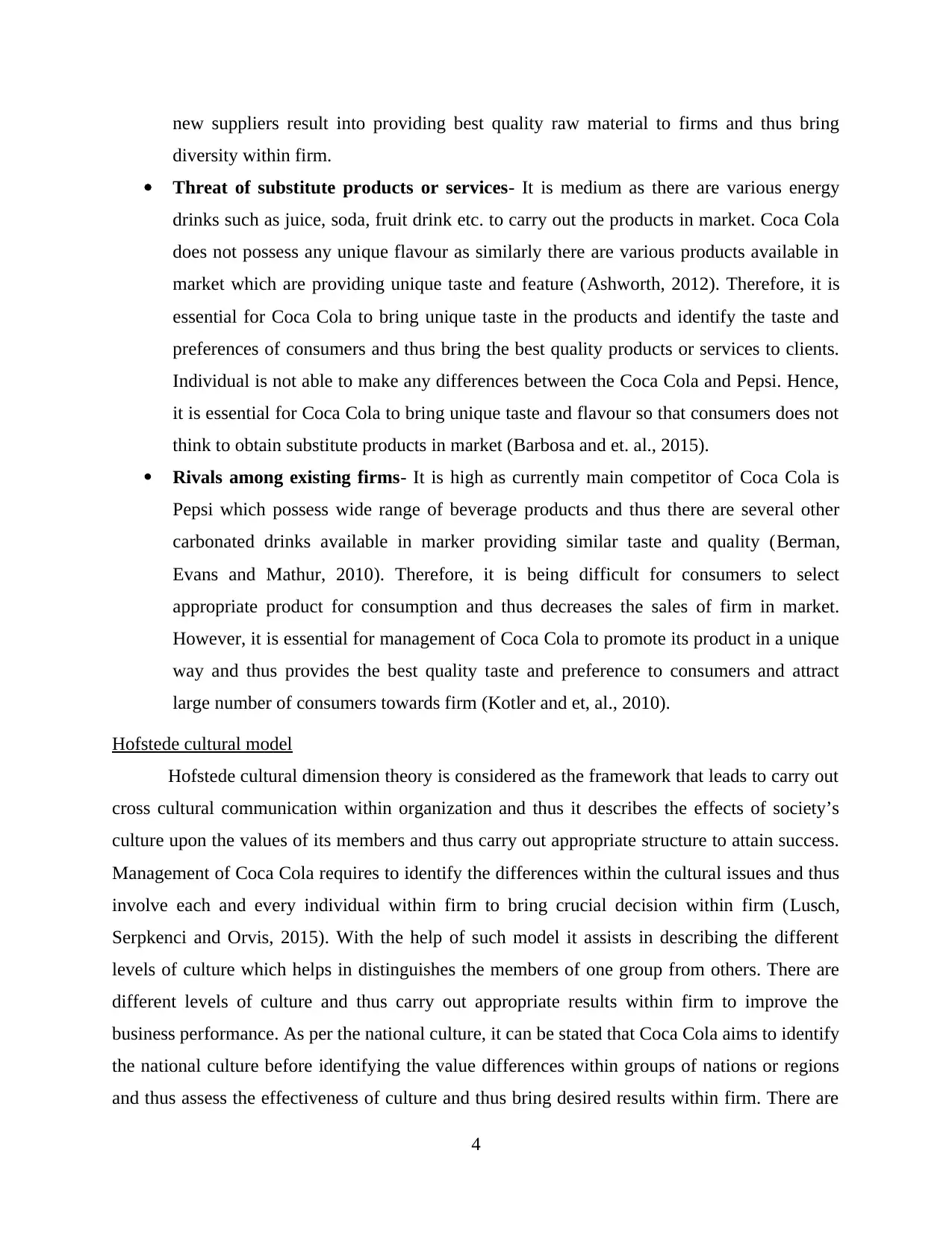
new suppliers result into providing best quality raw material to firms and thus bring
diversity within firm.
Threat of substitute products or services- It is medium as there are various energy
drinks such as juice, soda, fruit drink etc. to carry out the products in market. Coca Cola
does not possess any unique flavour as similarly there are various products available in
market which are providing unique taste and feature (Ashworth, 2012). Therefore, it is
essential for Coca Cola to bring unique taste in the products and identify the taste and
preferences of consumers and thus bring the best quality products or services to clients.
Individual is not able to make any differences between the Coca Cola and Pepsi. Hence,
it is essential for Coca Cola to bring unique taste and flavour so that consumers does not
think to obtain substitute products in market (Barbosa and et. al., 2015).
Rivals among existing firms- It is high as currently main competitor of Coca Cola is
Pepsi which possess wide range of beverage products and thus there are several other
carbonated drinks available in marker providing similar taste and quality (Berman,
Evans and Mathur, 2010). Therefore, it is being difficult for consumers to select
appropriate product for consumption and thus decreases the sales of firm in market.
However, it is essential for management of Coca Cola to promote its product in a unique
way and thus provides the best quality taste and preference to consumers and attract
large number of consumers towards firm (Kotler and et, al., 2010).
Hofstede cultural model
Hofstede cultural dimension theory is considered as the framework that leads to carry out
cross cultural communication within organization and thus it describes the effects of society’s
culture upon the values of its members and thus carry out appropriate structure to attain success.
Management of Coca Cola requires to identify the differences within the cultural issues and thus
involve each and every individual within firm to bring crucial decision within firm (Lusch,
Serpkenci and Orvis, 2015). With the help of such model it assists in describing the different
levels of culture which helps in distinguishes the members of one group from others. There are
different levels of culture and thus carry out appropriate results within firm to improve the
business performance. As per the national culture, it can be stated that Coca Cola aims to identify
the national culture before identifying the value differences within groups of nations or regions
and thus assess the effectiveness of culture and thus bring desired results within firm. There are
4
diversity within firm.
Threat of substitute products or services- It is medium as there are various energy
drinks such as juice, soda, fruit drink etc. to carry out the products in market. Coca Cola
does not possess any unique flavour as similarly there are various products available in
market which are providing unique taste and feature (Ashworth, 2012). Therefore, it is
essential for Coca Cola to bring unique taste in the products and identify the taste and
preferences of consumers and thus bring the best quality products or services to clients.
Individual is not able to make any differences between the Coca Cola and Pepsi. Hence,
it is essential for Coca Cola to bring unique taste and flavour so that consumers does not
think to obtain substitute products in market (Barbosa and et. al., 2015).
Rivals among existing firms- It is high as currently main competitor of Coca Cola is
Pepsi which possess wide range of beverage products and thus there are several other
carbonated drinks available in marker providing similar taste and quality (Berman,
Evans and Mathur, 2010). Therefore, it is being difficult for consumers to select
appropriate product for consumption and thus decreases the sales of firm in market.
However, it is essential for management of Coca Cola to promote its product in a unique
way and thus provides the best quality taste and preference to consumers and attract
large number of consumers towards firm (Kotler and et, al., 2010).
Hofstede cultural model
Hofstede cultural dimension theory is considered as the framework that leads to carry out
cross cultural communication within organization and thus it describes the effects of society’s
culture upon the values of its members and thus carry out appropriate structure to attain success.
Management of Coca Cola requires to identify the differences within the cultural issues and thus
involve each and every individual within firm to bring crucial decision within firm (Lusch,
Serpkenci and Orvis, 2015). With the help of such model it assists in describing the different
levels of culture which helps in distinguishes the members of one group from others. There are
different levels of culture and thus carry out appropriate results within firm to improve the
business performance. As per the national culture, it can be stated that Coca Cola aims to identify
the national culture before identifying the value differences within groups of nations or regions
and thus assess the effectiveness of culture and thus bring desired results within firm. There are
4
⊘ This is a preview!⊘
Do you want full access?
Subscribe today to unlock all pages.

Trusted by 1+ million students worldwide
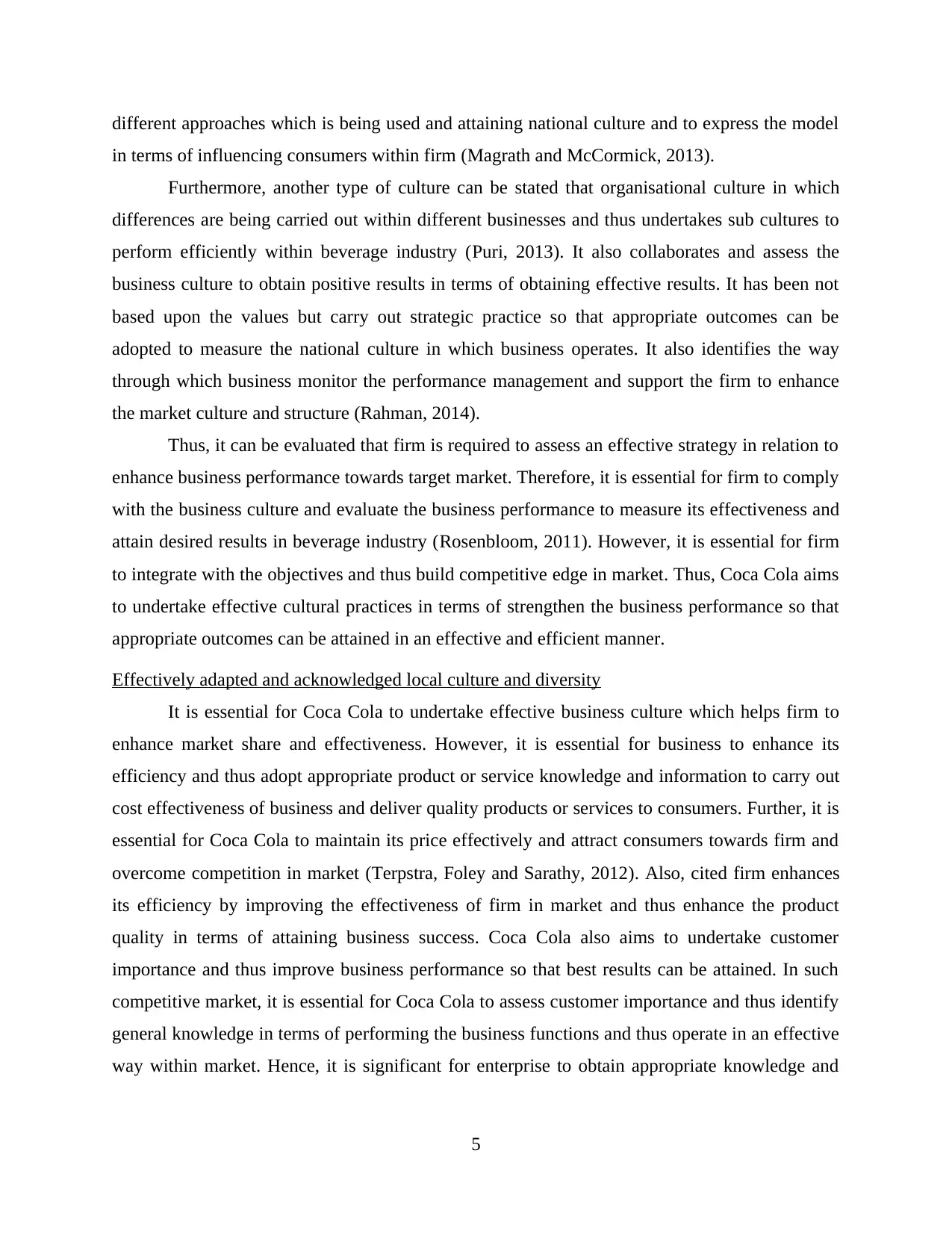
different approaches which is being used and attaining national culture and to express the model
in terms of influencing consumers within firm (Magrath and McCormick, 2013).
Furthermore, another type of culture can be stated that organisational culture in which
differences are being carried out within different businesses and thus undertakes sub cultures to
perform efficiently within beverage industry (Puri, 2013). It also collaborates and assess the
business culture to obtain positive results in terms of obtaining effective results. It has been not
based upon the values but carry out strategic practice so that appropriate outcomes can be
adopted to measure the national culture in which business operates. It also identifies the way
through which business monitor the performance management and support the firm to enhance
the market culture and structure (Rahman, 2014).
Thus, it can be evaluated that firm is required to assess an effective strategy in relation to
enhance business performance towards target market. Therefore, it is essential for firm to comply
with the business culture and evaluate the business performance to measure its effectiveness and
attain desired results in beverage industry (Rosenbloom, 2011). However, it is essential for firm
to integrate with the objectives and thus build competitive edge in market. Thus, Coca Cola aims
to undertake effective cultural practices in terms of strengthen the business performance so that
appropriate outcomes can be attained in an effective and efficient manner.
Effectively adapted and acknowledged local culture and diversity
It is essential for Coca Cola to undertake effective business culture which helps firm to
enhance market share and effectiveness. However, it is essential for business to enhance its
efficiency and thus adopt appropriate product or service knowledge and information to carry out
cost effectiveness of business and deliver quality products or services to consumers. Further, it is
essential for Coca Cola to maintain its price effectively and attract consumers towards firm and
overcome competition in market ( Terpstra, Foley and Sarathy, 2012). Also, cited firm enhances
its efficiency by improving the effectiveness of firm in market and thus enhance the product
quality in terms of attaining business success. Coca Cola also aims to undertake customer
importance and thus improve business performance so that best results can be attained. In such
competitive market, it is essential for Coca Cola to assess customer importance and thus identify
general knowledge in terms of performing the business functions and thus operate in an effective
way within market. Hence, it is significant for enterprise to obtain appropriate knowledge and
5
in terms of influencing consumers within firm (Magrath and McCormick, 2013).
Furthermore, another type of culture can be stated that organisational culture in which
differences are being carried out within different businesses and thus undertakes sub cultures to
perform efficiently within beverage industry (Puri, 2013). It also collaborates and assess the
business culture to obtain positive results in terms of obtaining effective results. It has been not
based upon the values but carry out strategic practice so that appropriate outcomes can be
adopted to measure the national culture in which business operates. It also identifies the way
through which business monitor the performance management and support the firm to enhance
the market culture and structure (Rahman, 2014).
Thus, it can be evaluated that firm is required to assess an effective strategy in relation to
enhance business performance towards target market. Therefore, it is essential for firm to comply
with the business culture and evaluate the business performance to measure its effectiveness and
attain desired results in beverage industry (Rosenbloom, 2011). However, it is essential for firm
to integrate with the objectives and thus build competitive edge in market. Thus, Coca Cola aims
to undertake effective cultural practices in terms of strengthen the business performance so that
appropriate outcomes can be attained in an effective and efficient manner.
Effectively adapted and acknowledged local culture and diversity
It is essential for Coca Cola to undertake effective business culture which helps firm to
enhance market share and effectiveness. However, it is essential for business to enhance its
efficiency and thus adopt appropriate product or service knowledge and information to carry out
cost effectiveness of business and deliver quality products or services to consumers. Further, it is
essential for Coca Cola to maintain its price effectively and attract consumers towards firm and
overcome competition in market ( Terpstra, Foley and Sarathy, 2012). Also, cited firm enhances
its efficiency by improving the effectiveness of firm in market and thus enhance the product
quality in terms of attaining business success. Coca Cola also aims to undertake customer
importance and thus improve business performance so that best results can be attained. In such
competitive market, it is essential for Coca Cola to assess customer importance and thus identify
general knowledge in terms of performing the business functions and thus operate in an effective
way within market. Hence, it is significant for enterprise to obtain appropriate knowledge and
5
Paraphrase This Document
Need a fresh take? Get an instant paraphrase of this document with our AI Paraphraser
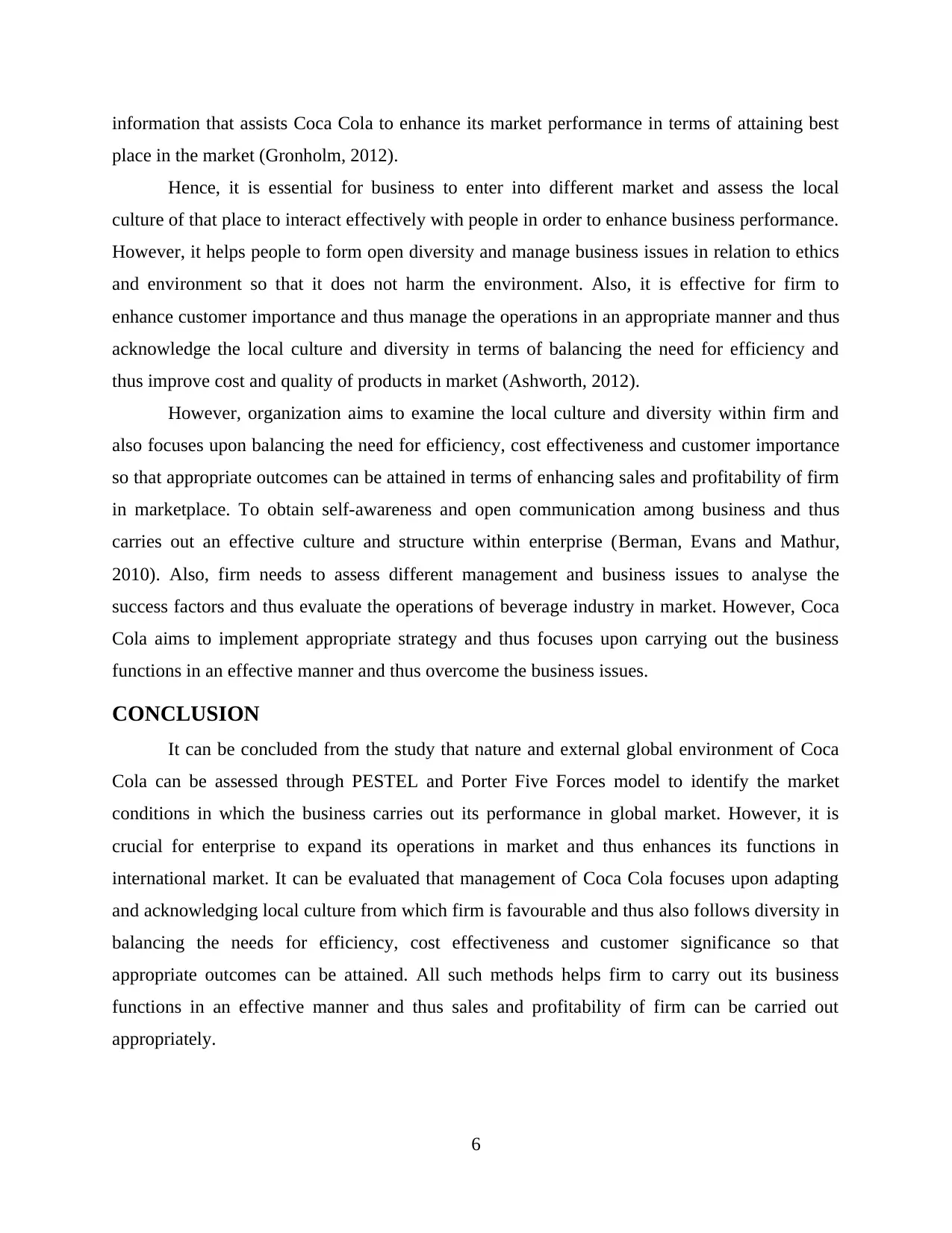
information that assists Coca Cola to enhance its market performance in terms of attaining best
place in the market ( Gronholm, 2012).
Hence, it is essential for business to enter into different market and assess the local
culture of that place to interact effectively with people in order to enhance business performance.
However, it helps people to form open diversity and manage business issues in relation to ethics
and environment so that it does not harm the environment. Also, it is effective for firm to
enhance customer importance and thus manage the operations in an appropriate manner and thus
acknowledge the local culture and diversity in terms of balancing the need for efficiency and
thus improve cost and quality of products in market (Ashworth, 2012).
However, organization aims to examine the local culture and diversity within firm and
also focuses upon balancing the need for efficiency, cost effectiveness and customer importance
so that appropriate outcomes can be attained in terms of enhancing sales and profitability of firm
in marketplace. To obtain self-awareness and open communication among business and thus
carries out an effective culture and structure within enterprise (Berman, Evans and Mathur,
2010). Also, firm needs to assess different management and business issues to analyse the
success factors and thus evaluate the operations of beverage industry in market. However, Coca
Cola aims to implement appropriate strategy and thus focuses upon carrying out the business
functions in an effective manner and thus overcome the business issues.
CONCLUSION
It can be concluded from the study that nature and external global environment of Coca
Cola can be assessed through PESTEL and Porter Five Forces model to identify the market
conditions in which the business carries out its performance in global market. However, it is
crucial for enterprise to expand its operations in market and thus enhances its functions in
international market. It can be evaluated that management of Coca Cola focuses upon adapting
and acknowledging local culture from which firm is favourable and thus also follows diversity in
balancing the needs for efficiency, cost effectiveness and customer significance so that
appropriate outcomes can be attained. All such methods helps firm to carry out its business
functions in an effective manner and thus sales and profitability of firm can be carried out
appropriately.
6
place in the market ( Gronholm, 2012).
Hence, it is essential for business to enter into different market and assess the local
culture of that place to interact effectively with people in order to enhance business performance.
However, it helps people to form open diversity and manage business issues in relation to ethics
and environment so that it does not harm the environment. Also, it is effective for firm to
enhance customer importance and thus manage the operations in an appropriate manner and thus
acknowledge the local culture and diversity in terms of balancing the need for efficiency and
thus improve cost and quality of products in market (Ashworth, 2012).
However, organization aims to examine the local culture and diversity within firm and
also focuses upon balancing the need for efficiency, cost effectiveness and customer importance
so that appropriate outcomes can be attained in terms of enhancing sales and profitability of firm
in marketplace. To obtain self-awareness and open communication among business and thus
carries out an effective culture and structure within enterprise (Berman, Evans and Mathur,
2010). Also, firm needs to assess different management and business issues to analyse the
success factors and thus evaluate the operations of beverage industry in market. However, Coca
Cola aims to implement appropriate strategy and thus focuses upon carrying out the business
functions in an effective manner and thus overcome the business issues.
CONCLUSION
It can be concluded from the study that nature and external global environment of Coca
Cola can be assessed through PESTEL and Porter Five Forces model to identify the market
conditions in which the business carries out its performance in global market. However, it is
crucial for enterprise to expand its operations in market and thus enhances its functions in
international market. It can be evaluated that management of Coca Cola focuses upon adapting
and acknowledging local culture from which firm is favourable and thus also follows diversity in
balancing the needs for efficiency, cost effectiveness and customer significance so that
appropriate outcomes can be attained. All such methods helps firm to carry out its business
functions in an effective manner and thus sales and profitability of firm can be carried out
appropriately.
6
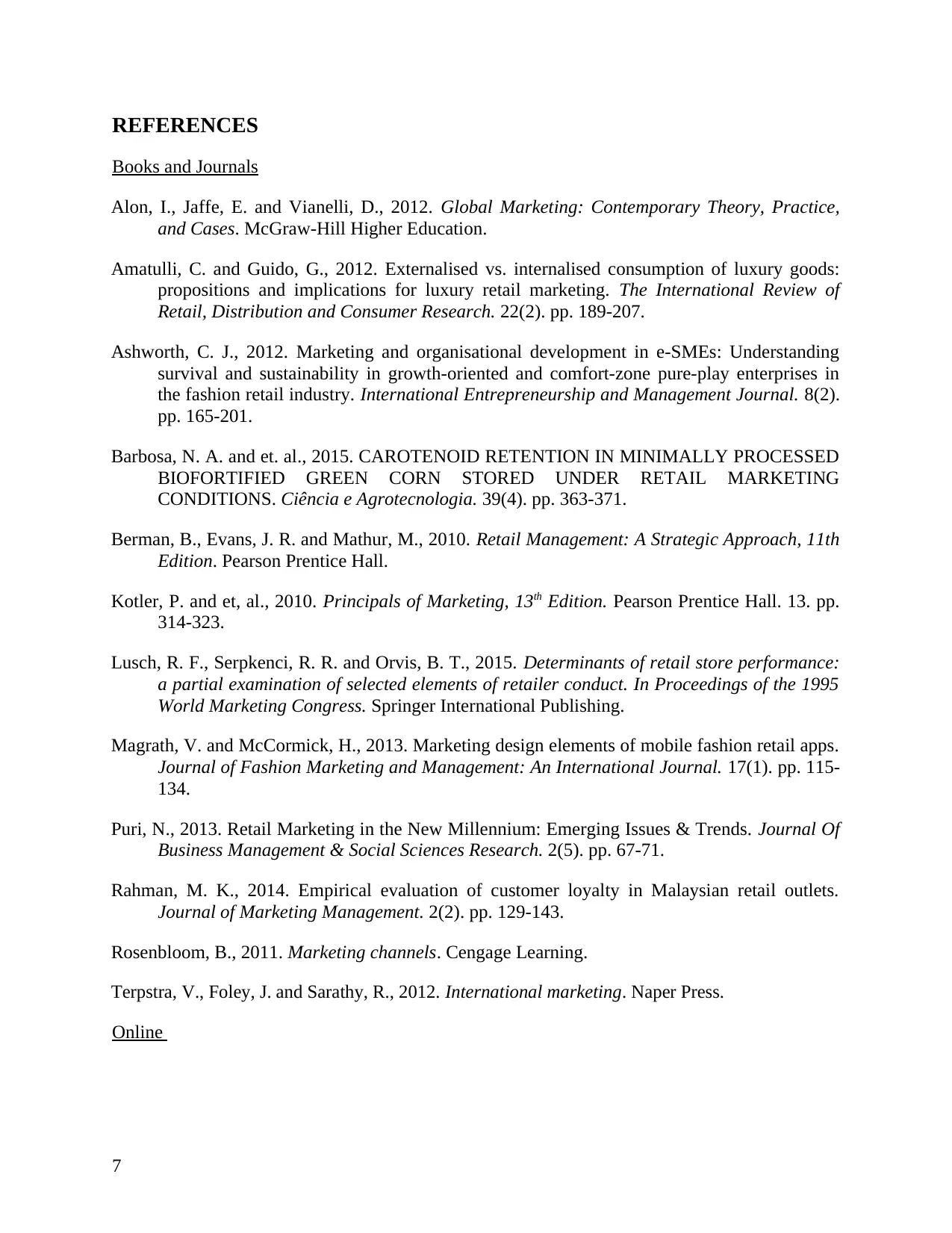
REFERENCES
Books and Journals
Alon, I., Jaffe, E. and Vianelli, D., 2012. Global Marketing: Contemporary Theory, Practice,
and Cases. McGraw-Hill Higher Education.
Amatulli, C. and Guido, G., 2012. Externalised vs. internalised consumption of luxury goods:
propositions and implications for luxury retail marketing. The International Review of
Retail, Distribution and Consumer Research. 22(2). pp. 189-207.
Ashworth, C. J., 2012. Marketing and organisational development in e-SMEs: Understanding
survival and sustainability in growth-oriented and comfort-zone pure-play enterprises in
the fashion retail industry. International Entrepreneurship and Management Journal. 8(2).
pp. 165-201.
Barbosa, N. A. and et. al., 2015. CAROTENOID RETENTION IN MINIMALLY PROCESSED
BIOFORTIFIED GREEN CORN STORED UNDER RETAIL MARKETING
CONDITIONS. Ciência e Agrotecnologia. 39(4). pp. 363-371.
Berman, B., Evans, J. R. and Mathur, M., 2010. Retail Management: A Strategic Approach, 11th
Edition. Pearson Prentice Hall .
Kotler, P. and et, al., 2010. Principals of Marketing, 13th Edition. Pearson Prentice Hall. 13. pp.
314-323.
Lusch, R. F., Serpkenci, R. R. and Orvis, B. T., 2015. Determinants of retail store performance:
a partial examination of selected elements of retailer conduct. In Proceedings of the 1995
World Marketing Congress. Springer International Publishing.
Magrath, V. and McCormick, H., 2013. Marketing design elements of mobile fashion retail apps.
Journal of Fashion Marketing and Management: An International Journal. 17(1). pp. 115-
134.
Puri, N., 2013. Retail Marketing in the New Millennium: Emerging Issues & Trends. Journal Of
Business Management & Social Sciences Research. 2(5). pp. 67-71.
Rahman, M. K., 2014. Empirical evaluation of customer loyalty in Malaysian retail outlets.
Journal of Marketing Management. 2(2). pp. 129-143.
Rosenbloom, B., 2011. Marketing channels. Cengage Learning.
Terpstra, V., Foley, J. and Sarathy, R., 2012. International marketing. Naper Press.
Online
7
Books and Journals
Alon, I., Jaffe, E. and Vianelli, D., 2012. Global Marketing: Contemporary Theory, Practice,
and Cases. McGraw-Hill Higher Education.
Amatulli, C. and Guido, G., 2012. Externalised vs. internalised consumption of luxury goods:
propositions and implications for luxury retail marketing. The International Review of
Retail, Distribution and Consumer Research. 22(2). pp. 189-207.
Ashworth, C. J., 2012. Marketing and organisational development in e-SMEs: Understanding
survival and sustainability in growth-oriented and comfort-zone pure-play enterprises in
the fashion retail industry. International Entrepreneurship and Management Journal. 8(2).
pp. 165-201.
Barbosa, N. A. and et. al., 2015. CAROTENOID RETENTION IN MINIMALLY PROCESSED
BIOFORTIFIED GREEN CORN STORED UNDER RETAIL MARKETING
CONDITIONS. Ciência e Agrotecnologia. 39(4). pp. 363-371.
Berman, B., Evans, J. R. and Mathur, M., 2010. Retail Management: A Strategic Approach, 11th
Edition. Pearson Prentice Hall .
Kotler, P. and et, al., 2010. Principals of Marketing, 13th Edition. Pearson Prentice Hall. 13. pp.
314-323.
Lusch, R. F., Serpkenci, R. R. and Orvis, B. T., 2015. Determinants of retail store performance:
a partial examination of selected elements of retailer conduct. In Proceedings of the 1995
World Marketing Congress. Springer International Publishing.
Magrath, V. and McCormick, H., 2013. Marketing design elements of mobile fashion retail apps.
Journal of Fashion Marketing and Management: An International Journal. 17(1). pp. 115-
134.
Puri, N., 2013. Retail Marketing in the New Millennium: Emerging Issues & Trends. Journal Of
Business Management & Social Sciences Research. 2(5). pp. 67-71.
Rahman, M. K., 2014. Empirical evaluation of customer loyalty in Malaysian retail outlets.
Journal of Marketing Management. 2(2). pp. 129-143.
Rosenbloom, B., 2011. Marketing channels. Cengage Learning.
Terpstra, V., Foley, J. and Sarathy, R., 2012. International marketing. Naper Press.
Online
7
⊘ This is a preview!⊘
Do you want full access?
Subscribe today to unlock all pages.

Trusted by 1+ million students worldwide
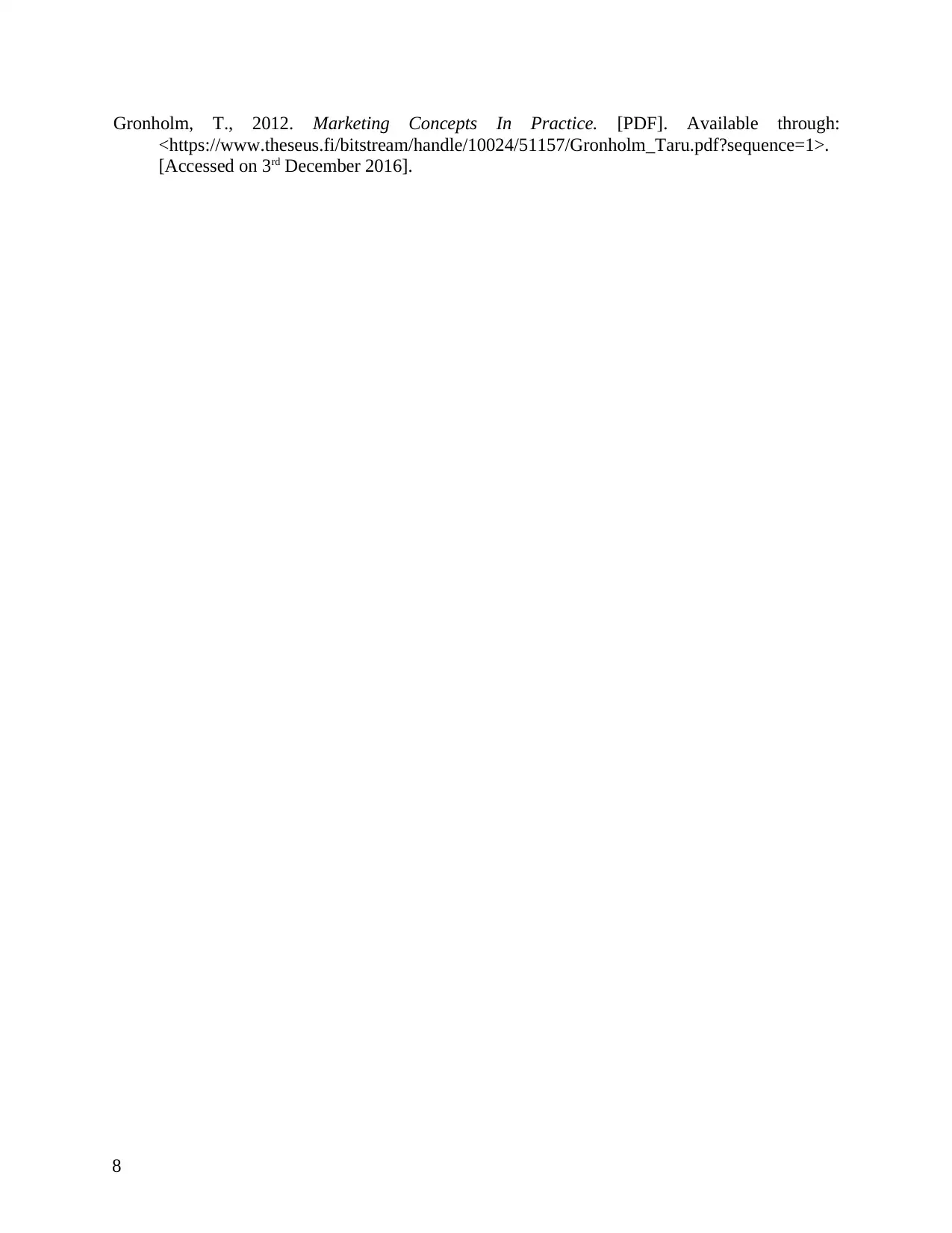
Gronholm, T., 2012. Marketing Concepts In Practice. [PDF]. Available through:
<https://www.theseus.fi/bitstream/handle/10024/51157/Gronholm_Taru.pdf?sequence=1>.
[Accessed on 3 rd December 2016].
8
<https://www.theseus.fi/bitstream/handle/10024/51157/Gronholm_Taru.pdf?sequence=1>.
[Accessed on 3 rd December 2016].
8
1 out of 10
Related Documents
Your All-in-One AI-Powered Toolkit for Academic Success.
+13062052269
info@desklib.com
Available 24*7 on WhatsApp / Email
![[object Object]](/_next/static/media/star-bottom.7253800d.svg)
Unlock your academic potential
Copyright © 2020–2025 A2Z Services. All Rights Reserved. Developed and managed by ZUCOL.




